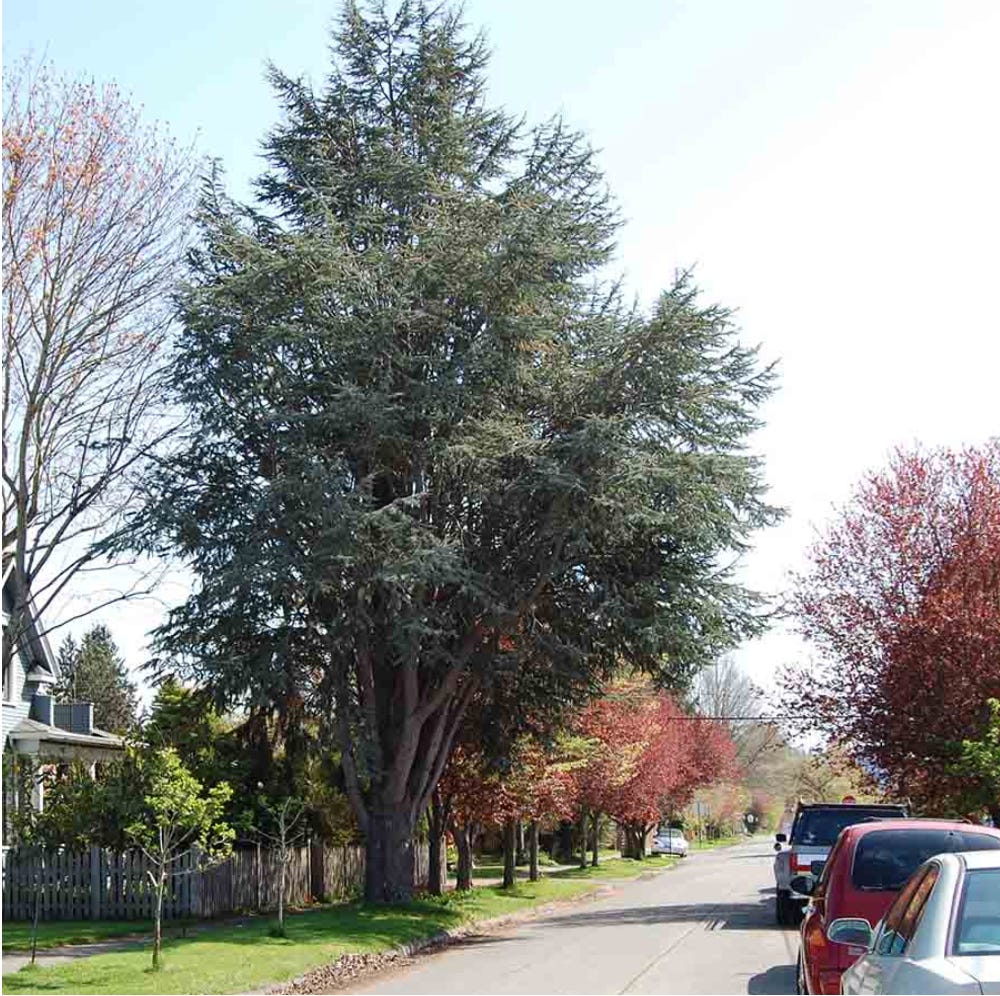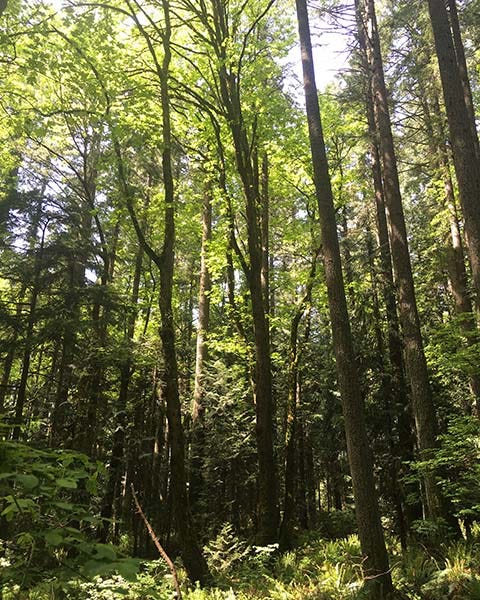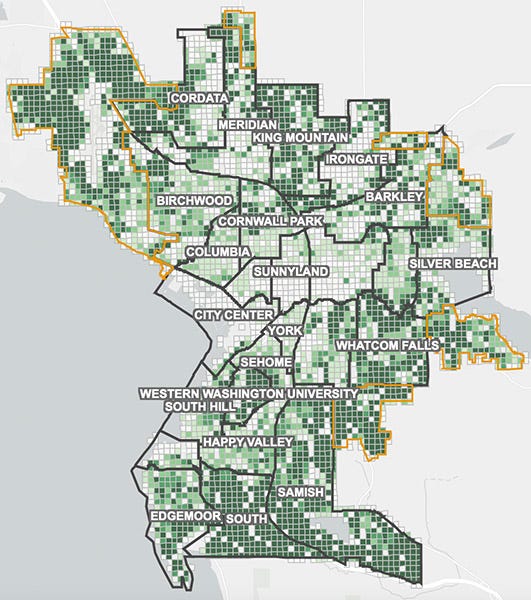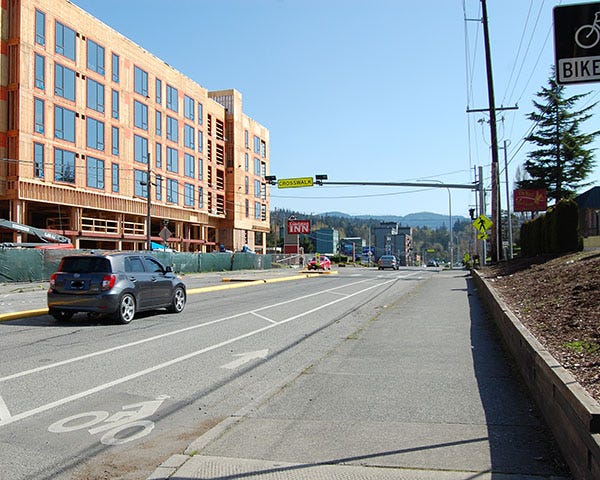City seeks balance: housing needs and forest benefits
Bellingham faces the challenge of building homes to meet housing needs while preserving trees for public and environmental health.

By Clifford Heberden
Urban forests are vital components of healthy communities.
From backyard apple trees in Sunnyland to undeveloped forested acreage on Sehome Hill, trees provide public health benefits, animal habitat, watershed management, climate change mitigation and pollution reduction.
They also take up space.
With a crisis in affordable housing, Bellingham is crafting a management plan to balance the need for urban development and the safeguarding of its urban forests.
The Legislature’s deliberation over a bill allowing increased density in single-family zones (HB 1110) ignited discussions about multifamily housing, upzoning and urban growth areas that revolve around sustainability, housing opportunity and affordability. (The bill was sent to Gov. Jay Inslee for signature on April 21.)
Blake Lyon, director of Planning and Community Development for the City of Bellingham, said the City is working with the existing land to minimize impact while meeting housing needs. Bellingham is looking to complete an Urban Forestry Management Plan for approval between August and October this year. The public will have opportunity to provide feedback on potential actions once a draft plan is available for review.
Developing a new plan includes a review of the balance between development and natural resources with a specific focus on trees and forests, enabling the city to refine its approach as necessary, said Analiese Burns, Habitat and Restoration Manager for Bellingham’s Natural Resources Department.

All trees in an urban area, whether individually in gardens or planting strips or by the hundreds in parks or greenways, compose the urban forest. The shade coverage they provide, as seen from above, is the urban canopy.
Plant, protect, engage
Nonprofits such as the Whatcom Million Trees Project already are marshaling volunteers to plant new trees and protect existing ones.
“All three pieces” — planting, protection and public engagement — “are intertwined and work with each other,” said Whatcom Million Trees executive director Michael Feerer. “We need all of those to build up our climate resilience to face the climate crisis.”
Because newly planted trees won’t fully benefit the climate and biodiversity for 15 or 20 years, Feerer said it is important to protect young and old trees alike.
Feerer said several Western Washington cities already have more progressive tree protection ordinances in place than Bellingham. That makes the timing of the creation of its Urban Forestry Management Plan urgent for the city’s urban forest.
“There will undoubtedly be several dozen elements … that hopefully will take a big step forward so Bellingham can catch up to numerous other cities that had been having these kinds of rules in place for many, many years,” he said.
The City’s Consolidated Plan for 2023–2027 asserts that housing in Bellingham is too expensive for its growing population and doesn’t meet the needs of the town’s demographics.
“We’re trying to get housing numbers up; we’re trying to keep costs to the point where people can afford the units that they’re living in, whether that’s rental or ownership,” Lyon said. “But we want to protect and preserve our community and our environment. It is a challenge to do both.”
Contributions of urban trees
Quantifying what urban trees can do is part of that effort. Both the individual trees and the amount of shade they collectively provide influence the environment and climate in a variety of ways.
According to the City, Bellingham’s urban forest offsets emissions from 6,653 passenger vehicles per year through sequestration; estimates through i-Tree Canopy indicate the city’s trees help remove more than 302 tons of air pollution each year.
Burns said the forest canopy is one of many ways to address environmental impacts, though not sufficient on its own.
Most of the larger trees and mature forests reside in Bellingham’s urban growth areas, which represent an additional 2,325 acres of forest.
Burns said development decisions in those areas need to weigh values to determine what is in the best interest of the community.

“Such values include protecting high-value habitats, planning for climate change, providing affordable housing, protecting water quality, providing equitable community services and maintaining public safety,” Burns said.
Keeping the canopy
Bellingham has 40% percent tree cover within its city limits. The City’s goal is to maintain that percentage overall and to provide equity across neighborhoods.
Lyon cites urban villages and compact in-fill areas as tools to allow for development while sustaining Bellingham’s current environment. “By having those compact urban areas and those urban villages, among other things, it helps to take the development pressures off of some of those other areas that have more green and more open space, like Lake Padden or Lake Whatcom.”
Permit data as of March 2022 indicates a total of 2,800 housing units were added in designated urban villages, representing 40% of all new housing in Bellingham since 2006.
“Keeping that perspective in mind is certainly beneficial when it comes to thinking about how we manage our growth overall,” Lyon said.
Voice of experience elsewhere
As it grows in population and density, Bellingham can look at Seattle for one example of urban forestry management in fully developed areas.
According to Seattle’s 2020 Urban Forest Management Plan, the Green Cities Research Alliance estimated that “the replacement value of Seattle’s existing urban forest (the cost to re-plant trees and nurture them to their current size) is close to $5 billion.”
To support the urban forest through Seattle’s redevelopment, Brennon Staley, strategic advisor for the Office and Planning and Community Development, said there will be requirements that incentivize the preservation of existing trees or require tree planting on streets and properties.
But as Seattle, like Bellingham, works to provide housing opportunities across the city, Staley said a trade-off is inevitable.
“When new development happens, in the short term, it definitely decreases the canopy cover on-site, but then it also results in the planting of a lot of new trees,” Staley said. “Over time, that creates the potential for getting back to canopy cover that we used to have.”
Staley said development in Seattle is a clear win in terms of natural resources and sustainability, as greater density in the city prevents urban sprawl.
“Within Seattle, it becomes a lot more complicated; obviously as you accommodate more housing in the city, there’s just less space for tree planting,” Staley said. “But there’s a lot of things you can do to make sure that that space you do have is well used.”
Planning with nature in mind
As a former architect and urban designer, Feerer suggested Bellingham could apply nature-integrated design in new developments and urban neighborhoods, with areas designed to respond to the needs of their communities including access to nature. Examples might include green roofs and designs that provide sunlight and supporting structures for plants.
As yet, Feerer said, “there just hasn’t been the kind of encouragement much to make that happen here. We’re hopeful, again, that [Bellingham’s] Urban Forestry Management Plan can help point the way to some of that, and if somehow it doesn’t, we’ll do our best to pave the way towards that.”

Staley said the High Point neighborhood in Seattle, redeveloped in its entirety, is a good example of that concept at work.
“Because of the work they did to preserve trees and plant new ones, [the neighborhood] has more canopy today than it did 10 years ago when that development happened,” Staley said.
The equity factor
In Seattle, the issue of tree equity in neighborhoods around the city is a big part of the commission’s work. While the city’s overall canopy cover is 28%, “there are certain areas of the city that have much less than 20% canopy,” said Patti Bakker, coordinator for Seattle’s Urban Forestry Commission. The City is aiming for at least 30% citywide.
For Bellingham, Burns said the canopy change analysis included an equity analysis that showed lower canopy coverage in areas with denser development.
“Equitable access to forest benefits is an important Bellingham community value incorporated into the Urban Forestry Management Plan process,” Burns said. “As part of developing the plan, staff and consultants will evaluate ways to increase equity.”
Feerer said a neighborhood-by-neighborhood analysis in Bellingham shows considerable disparity among neighborhoods in tree canopy coverage. Sunnyland, at 14% and City Center, at 10%, had much lower canopy per the 2018 analysis than South (73%) and Samish (66%).
With weather events like flooding, torrential rains and extreme heat becoming more common, Feerer said these disparities are impacting the environment and residents.
“The urban neighborhoods that are lacking trees are really feeling it on both sides of the seasons because they don’t have that buffering that trees do,” Feerer said.
While the City works on its plan, and as the planting season passes, Feerer said the Whatcom Million Trees Project will focus on preservation and maintenance, such as removing English ivy from trees around the city to save them from disease.
By organizing work parties and getting people to engage with their trees and the environment, the nonprofit has gathered around 600 volunteers since its inception two years ago.
“Sure we’re doing a lot of tree work but underneath that, on a deeper level, I think we’re building up hope and empowering people through hands-on action,” Feerer said.
In her poem “The Snow Pearls,” early Bellingham author Ella Higginson — Washington’s poet laureate in 1931 — described the Pacific Northwest as a place where “every fir tree flashes out like a tall gilded spire.”
With modern-day challenges ahead of the region, cities will have to find ways to preserve that heritage for all to benefit.
— Reported by Clifford Heberden
Subscribe: Sign up for our weekly newsletter for all the news, delivered.
Comment: We welcome letters to the editor responding to or amplifying subjects addressed in the Salish Current.
Contribute: To contribute a Community Voices essay, email your subject proposal to Managing Editor Mike Sato (msato@rockisland.com) and he will respond with guidelines.
Donate: Support nonpartisan, fact-based, no-paywall local journalism from the Salish Current.
written by:
Clifford Heberden (he/him) is a freelancer with Salish Current with an interest in climate legislation and mitigation. Born and raised on the outskirts of Paris, he graduated with a Baccalauréat Economique et Social before moving to Washington state in 2019. He is pursuing a news/editorial major at Western Washington University with a minor in philosophy. His reporting is focused on the environment but Cliff has also looked into issues interconnected with climate change like environmental justice and immigration. His Twitter handle is @cliffbutonline.


